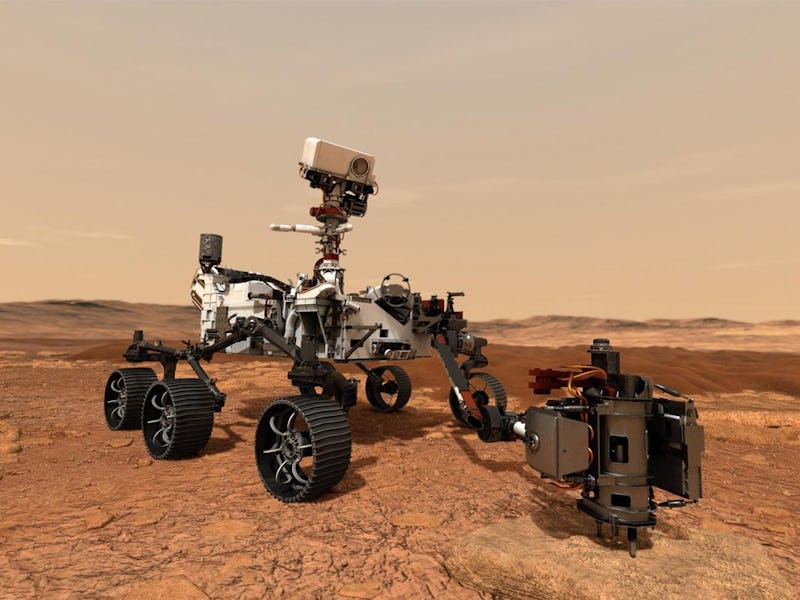NASA’s Mars 2020 rover takes its first test drive
"We can do so much more."

Two weeks after landing on Mars, its newest robot inhabitant has already gone for its first stroll.
On Friday, NASA’s Jet Propulsion Laboratory announced mission engineers have — among other milestones — taken the Perseverance rover out on a test drive. The Mars 2020 rover only drove a few feet — a total of six-and-a-half meters, according to Anais Zarifian, Perseverance mobility test bed engineer.
“Now that we’ve shown that we’re able to drive and can do this, our mobility system is showing us that we can do so much more,” Zarifian said in a press conference Friday.
READ MORE PERSEVERANCE ROVER NEWS FROM INVERSE
The Perseverance rover has gone for its first drive, as the tire tracks well show.
Here's the background — Perseverance rover landed on Mars on February 18. Since then, the rover has completed a number of steps in preparation for its mission on Mars. First, it updated its computers, replacing the landing software with its exploration software. In addition, mission team members on Earth sent instructions to the rover to calibrate instruments for use in the main mission.
What's new — Although it was just a few meters (or about 20 feet), the short test drive represents a massive milestone in the mission. The short roll proved all six of Perseverance's wheels work as expected. Each wheel has an individual motor. The rover had previously only been tested out on Earth.
The six-wheel-drive robot can drive five times faster than the older, sister mission, Curiosity, though that's not saying much — it's top speed is a glacial 0.01 miles per hour. Unlike the older mission, Perseverance can perform analysis while moving, thanks to a secondary computer — as Zarifian says, Perseverance can "walk and chew gum at the same time."
The team also moved the instruments for the first time, including the Mars rover's robotic arm.
In addition to taking its wheels out for a spin, the Perseverance rover moved some of its instruments for the first time since landing on Mars.
In addition to these hardware tests, NASA shared a few other announcements — including some tantalizing clues to Perseverance's mission on Mars.
One of the most exciting announcements is to do with a first potential exploration site. The site could be seen in initial images from the rover — a rock outcropping with stratified layers, consistent with river deposits. At the press conference, the team referred to it as a delta.
These rocks are one indication that Perseverance is in the right place — it shows signs of having been carved by ancient rivers.
Before they can get the rover to the site, the team on Earth have to find a safe route for Perseverance to get from point A to point B. To make it more complicated, the route has to be scientifically interesting, too.
"Before we can figure out exploring the Jezero delta, we have to figure out how to get there," Katie Stack Morgan, Perseverance deputy project scientist, said Friday.
An orbital survey gives a suggested path, but the team needs to decide if it's better to go clockwise or counter-clockwise.
The team also revealed the name of the landing site — Perseverance's touchdown site has been named for science fiction author Octavia E. Butler, a pioneering, socially conscious writer best known for the Parable of the Sower series and Kindred.
Octavia E. Butler's name is now written in the history of Mars.
Morgan compared it to previous landing sites having been named for authors like Ray Bradbury. Science fiction continues to inspire people to go into careers in the sciences, she said.
What's next — The Mars 2020 mission isn't quite ready to drive in earnest — but soon Perseverance will really get rolling, Morgan said.
"I do think the minute the rover begins to move, we can consider ourselves explorers on Mars," Morgan said.
The team needs to better understand the terrain of Jezero Crater, and map out the best, safest, and most scientifically interesting path to take through the river delta. As seen in the below image, in which the white dot represents the rover, Perseverance may go on a clockwise or counter-clockwise path to get to Neretva Vallis.
The Perseverance rover team has an idea on where it wants the robot to go, but getting there has its own set of questions.
The rover will likely soon begin sampling rocks around its landing site, allowing for some science to be done even before the rover really gets moving. It will also set up a test of its helicopter Ingenuity, the first powered flight on another world.
This article was originally published on